| 4. Developing ecologically justified |
| |
| Developing ecologically justified is important to handle the ‘planet’ durably. In order to make our planet ‘exist longer’ the conscious behavior of man is conditional. Durability is not a fashion word in this respect but an intention that continues life. |
| |
| As an introduction to this chapter I will give a few assumptions that preceded this description |
| |
| |
| Assumptions |
• It is the way it is, it goes like it goes
Even if you would want it differently, reality remains reality. The interesting question is how we cope with reality.
• It never goes into two directions at the same time
Developments never go into the right and the wrong direction at the same time. You cannot be ill and better at the same time.
• Unpredictability is the only predictability
If the future is unpredictable, we could prepare ourselves for what we have to develop in the right way, but this can be the case for a part at most.
• Fighting against laws of nature is useless
It is important to distinguish between matters that you can influence and ones you cannot. Denying gravity does not make any impression on gravity itself.
• Building up good networks means surviving in a better way
Organisms that survive in a pleasant way have got networks around them that are necessary to make that possible. He who is friends with the greengrocer does not have to grow things himself.
• What is pressed must be able to express itself
Expressions are ‘feelings’. Every interaction has a result. ‘Result’ originates from Latin. Re-saltare means: recoiling. A result is literally that which recoils or strikes back, that which you get back and finish the experience.
• Replacing to concentrated areas is an osmotic process
Osmosis is a physical process at which a fluid runs through a semi-transmitting wall which lets through the fluids but not the dissolved substances. At osmosis the fluid streams from the side where the concentration of dissolved substances is lower to the side where the concentration is higher. In this way also economic migrants are leaving and people are drawn to the place ‘where things are going on’! So people are concentrated in a place where the concentration of for them interesting things is highest.
• Everybody is part of a bigger entity
It is good to realize you are an important part of life yourself but that it is only a very tiny part of an enormously big and complex entity. |
| |
He who is not strong…
In 2007 Marcel Dicke received the Spinoza prize. The professor entomology of the University of Wageningen does ecological research into the interaction between plants and insects. In 1986 he did his first big discovery. One did already know by then that plants could defend themselves against plant-eaters (such as insects and mites) by excreting a poisonous substance. But how it worked exactly one did not know until then. Dicke showed that some plants excrete certain substances to attract mites of prey. These mites of prey eat the plant-eating insects and mites but not the plant. In that way the plant protects itself against glutton.
Children, counsellors, institutions and organizations that are threatened should take care they are ‘excreting a smell’ that attracts individuals and parties which keep off the threats. Being interesting for important parties makes living/surviving comfortably easier.
|
| |
| You are expected to make choices the whole day. In the supermarket, in front of the television, at the computer, but also in counselling situations. Sometimes political, relational or pedagogic choices, but sometimes also strategic ones. In the dual systems that we evoke we are often asked to be in favour of or against, to choose left or right. But development is not caught by that choice. In that way it is not on the one hand or on the other hand that develops but it is in the tension between the two. |
| |
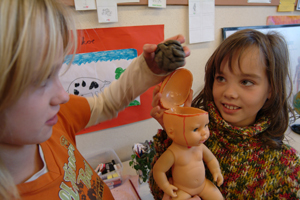 |
| |
| |
| Networking |
| Wielinga describes in his book Networking as living tissue (2001) four paradigms (convictions and values that lead to certain ways of acting). He distinguished between an instrumental, a strategic, a communicative and an ecological paradigm. The ecological paradigm is important for this discourse. |
| |
| The world is seen as a living organism such as cells, animals or ecological systems. Within such a system there are many networks with inside these other networks. The characteristic of networks is that they coupled structurally, sensitive to each other and responsive to each other. By an optimal exchange of information cells for example can function independently but also jointly. The networks distinguish ill from healthy. It goes ‘into the right way’ or ‘into the wrong way’. Therefore processes occur unpredictably and have a self-regulating character. Knowledge has here the character of ‘ability to get along with one’s environment adequately’. |
| |
| In order to make wellbeing and involvement as high as possible linkedness is indispensable. It is the literal linking between the networks. Important in this is of course the quality of interaction. |
| |
An ecological organisation is like a swarm of birds
- There are few rules (what would you have to agree about?)
- There is a high responsiveness (otherwise you will fly against the other one.)
- Your behaviour cannot be stimulated (if you pretend you can fly, you will have a problem in the swarm) |
| |
| In order to be able to look a bit into the networks we end up with the neurobiologists Maturana and Varela. They write in their book The tree of knowledge an fascinating essay about the unity of being and acting. I paraphrase a part after I have quoted them about the key notion: ‘autopoietic being’ |
| |
| |
| Man as an autopoietic being |
| Living being are characterized by their autopoietic organization. Autos means oneself and poiein means making. The self-creating being. What distinguishes living beings form non-living beings is that they themselves are the only product of themselves which means there is no distinction between producer and product. The producer ‘man’ produces the product ‘man’. The being and acting of an autopoietic unity are inseparable and that is what determines the specific nature of their organization. You are what you do. |
| |
Organisation refers to all the relationships that must exist between the components of a system. For example the relationship between metabolism (dynamics) and membrane (limit).
Structure refers to all the components which make the organisation function. For example the components to make a liver cell function as a liver cell.
|
| |
| |
| At the level of the cell |
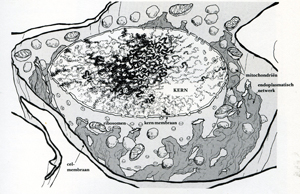 |
|
Every cell is different in structure. A toe cell is different in structure from a liver cell. But every cell is the same if is about organisation. The organization of a cell can be explained as following: the metabolism makes elements for the dynamics and for the membrane (the limitation). And the membrane makes elements for the metabolism. They are two aspects of the same, simultaneous process. This makes the limits stretchable and development possible. |
| |
| |
| At human level |
| Every human being is different in structure. A waterpolo-player is built differently from a ballet dancer. But every human being is the same in organisation. The organisation of a human being can be explained as follows: the ability to act determines who we are and ‘being’ determines the ability to act and the limits of it. They are two aspects of the same, simultaneous process. This makes the limits stretchable and development possible. |
| |
All life is complete
Every cell is an entity. Every organism is an entity. Every human being is an entity. The universe is an entity. An entity can be analysed but remains indivisible.
|
| |
I have a consultation at a medium-sized institution. Middle managers tell that they have problems with ’the course of things’. The management imposes matters on them which they have to ‘sell’ to the people on the work floor and these employees put problems on the table which they have to defend towards the management. They feel as in splits.
We look at this ’from the level of the cell’. We experience the dynamics at the employees, the limitation at the management. Up till now the management indicates the limit in the assumption that people can go on within these limits. (“We have compared everything and this is the best decision.”) Though, what the management does not realize is that the dynamics and limitation are two aspects of the same, simultaneous process. In other words: it the management defines a limit the dynamics react to that and forms (images of) an new limitation. Employees wonder if their motives have been considered, see new problems, have problems with the procedure of participation etc.
The middle managers develop a new strategy. They make the management imagine themselves in the dynamics of the employees and they make the employees imagine themselves in the (possible) motives of the limitation of the management. In due course they notice that both sections are going to think and speak from each other’s perspectives; that the management is more aimed at the experience of the employees and that the employees get a feeling for a larger perspective.
I wrote the next poem about the safe limitation of my youth: |
| |
Aa-side
I do not get further than the bridge
Every step is upon a former walk
The wind brings more than just the meadow
The air opens earlier
In shorts and wellies
In which socks were creeping to the front
We kicked a ball between pregnant heifers
And became champions of the world
You had to do with one little jet
The barbed wire we were aiming at
As if the calf was licking your fingers
The sparkling up to your bones
We were cowboys in rags
Do not romp while herding the cows
We were eating bacon and drinking coffee
A cap pistol in case of emergency
The warm sighing of cows above a ditch
Morning dew still on the ground
We sprayed milk into each other’s mouth
From a slightly tense foursome
Getting lost could happen only later
Around the Aa-side was a border
My memory plays just till the water
Beyond the Netherlands began |
|
 |
| |
If a person thinks of something (dynamics) and proposes that to others (limit) this will lead to new dynamics in those others and new limits become visible.
Interaction which is aimed at insight into one’s own dynamics and imagining oneself in the dynamics of the other one, makes awaking possible and a harmonic relationship imaginable. |
| |
| |
| Justification |
We know that structures differ. That justifies the uniqueness of man and the diversity in approach.
We know that organizations agree (metabolism and membrane are one: being and acting are one.). That justifies that man can only act from his ‘being’.
In this way man knows what he does and he does what he knows. You could say that humans act according to their ability and for instance not according to their ability of reflection. |
| |
| |
| What can you do? |
The limit of your ability (at a certain moment) determines your ability but also influences you.
I got children in my class that came from other schools. Some children ‘could not do arithmetic’. They had ever heard that (or more than once) or they had found this out experimentally. In any case they told it to themselves (often an inner voice) at the moment they were confronted with arithmetic tasks. You might say that their ability was determined by the limit which others or they themselves had established.
If I asked such a child: “How much is 1 + 1?” then the reaction always was “Yes, that is easy.” My next question would then be: “What else is easy? ” And from the moment that children started to tell that the limits were moving and a new open space developed, in which I could sometimes say: “Yes, but if you know that and that, then you can also….”
Vygotsky would say that the we try to find the area of the nearest development. Put more easily you could also state that you are going to look for what children can do, to look from there what the next (path-breaking) possibility could be.
In short the primary question is not “What cannot you do?” but indeed “What can you do?” |
| |
I recently asked a woman when she would go on a holiday. She told me that she had to wait until her 10-year-old son had returned from an international camp. He was in Sweden with children from twelve different countries. “And does he speak good English then?” was my surprised reaction. “No”, she answered, “he will do that as soon as he gets back.” |
| |
| |
| From which vision of humanity |
| It is important to find attuning to the vision of mankind (anthropological image) in organisations. Your vision of mankind determines how you ‘read’ and interpret the behaviour of somebody else. Man adapts to that situation according to his ability. This can be explained evolutionarily. It is not a coincidence that Eskimos do not come from Africa. For me there is no reason to believe that man is doing worse than he can. |
| *For a more elaborate description see : ‘Constructivism in a nutshell’ |
| |
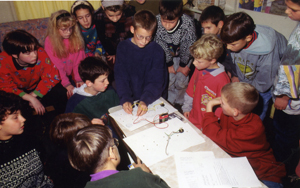 |
|
A lamp can burn if the voltage is on the closed circuit. If there is no lamp, no switch or no closed circuit then nothing burns. |
| |
 |
| |
| |
| Between overstress and under-stress |
| Without tension there is no development. In order to develop maximally the right tension is required. The tension between too much and too little stress. The tension between too difficult and too easy. Interactions and processes can be overstressed and under-stressed and can be schematically represented in a cross-model. Everything is interaction: a conversation with others, an activity with material, an idea about a situation. In every situation there is a tension between two forces. The inside and the outside world, he who sends and he who receives, two points of view, two opinions, two forces, two ways of looking etc. The possibility of a successful development for yourself and the other one is determined by the correctness of the tension. If the one develops well at the cost of the other (one arrow in the cross becomes longer) then the bow of tension will become slanting and for example aggression or apathy occurs. Constructive processes take place in the right tension (right at the top). The place where people are being well and are involved. So with sensitivity and imagining we know for sure ‘if we are doing well’. Are the arrows too short then nothing happens, is one arrow too long then a wrong tension develops. And if the arrows are equally long the right tension can be read on the interaction. The length does not matter: difficult and easy are not the criteria. |
| |
Unambiguous and ambiguous
Unambiguous is good for the policy.
Ambiguous is good for the development.
|
| |
| Competent behaviour is determined among others by the tension between being able to and daring to. It is literally the phenomenon of the tension in a positive sense which makes developing into an exciting occurrence. Systems that take out the tension by a too great predictability in division in time, contents etc. take away the essence of development. That does injustice to the knowledge that tension is the result of two aspects of the same phenomenon. This can be explained at the level of the cell and can be translated to current systems. It is not a matter of or but of and. |
| |
| A number of examples: |
| At capacities (or competencies in the sense of capability, suitability) other qualities next to knowledge also play a part such as courage. What is the competence of a child with a large vocabulary that is sitting in a circle in which it does not dare to speak? |
| |
| A human being acts in a situation according to his ability and not only according to his knowledge. He does what he is able to and knows and he does what he is able to and what he knows. |
| |
 |
| |
| People who can do a lot but dare to do little, get frustrated. People who can do little but dare to do much exhibit thoughtless and unconcerned behaviour. People at who being able and daring are attuned show themselves as competent. |
| |
| |
| Challenge and balance |
| There is a contradiction which complicates the counselling of developmental processes. On the one hand the organism and its development exist by the grace of its being challenged: involvement. On the other hand that same organism is focussed on wanting to be in balance: wellbeing. There is an alternating tension between wanting to be challenged and wanting to be in balance. |
| |
| |
| An example |
| Children that are playing are challenged by their environment. The environment asks them questions which they answer with all their being. The interaction with the environment literally brings them in unbalance. The discoveries take children further in their thinking and acting. However, by nature the body is also aimed at restoring the balance. This photo gives a beautiful physical example of this. As a kind of scales (balance) the body corrects the movements back to the middle. |
| |
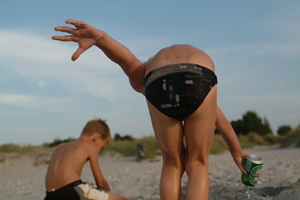 |
|
The phenomena challenge and balance make the necessity visible to view processes. It is of vital importance that children are challenged and it is of vital importance that children can get into balance. However, that cannot happen at the same time and certainly not always in class. The more flexibly these two phenomena can form from the organism the more self-evidently children can develop. The question is how much space there is to be really challenged and how much to be able to get really into balance. Can children become involved because they are really challenged? And when they are involved can they keep this ‘state of being’ or is it interrupted by the schedule? And is there a place where children can quiet down? |
| |
 |
Children’s initiative (horizontally)
Counsellors’ initiative (vertically)
|
| |
| In a strong offer-driven system the child has direct access to the subject. In a strong demand-driven system the risk is big that the child becomes its own norm. In an open space the counsellors and children steer in a ratio that fits with the situation in which the counsellor tries to increase the child’s initiative but he takes wellbeing and involvement as criteria. |
| |
| |
| Open space |
| Must the counsellor give as much autonomy as possible to the children or must he take care of the best possible offer? In my opinion two things must not be mixed up. From the tradition that the counsellor steered (from the method) we have to move of course to more children’s initiative. But in the daily practice one cannot put a stake on one aspect of the complete phenomenon. The tension must be put back. This can happen in the so-called open space. Characteristic for an open space, where wellbeing and involvement are high, is that counsellors and teachers have a grip on the way of working. Counsellors take care of a good offer and children take initiatives. Within these kinds of contexts it is not exactly clear anymore at a certain moment who is steering. Demand and offer can come from both the counsellors and the children. Then ‘developing’ becomes visible and feasible. |
| |
| The open space is the place where children and counselors have to learn from each other because they do discoveries inside and outside themselves. It is the place where the tension is maximal, where everybody feels that things are learnt. The tension between children and counselors, between children mutually, between demand and offer, between process and product, between wellbeing and involvement. It is the moments that everybody realizes that it ‘comes to the pinch’. That is only possible because of the interaction with each other and the environment. Learning does not take place without conflicts, it does not go on wheels, not by purely watching. Learning is exciting, very exciting! |
| |
A teacher in secondary education stuck to his ‘own way’ of working. He filled the blackboard with his writing in chalk. His students did not write with him but asked him to step aside, so that they could take a picture of it with their mobile phones. |
| |
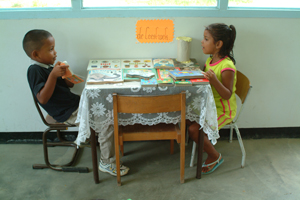 |
|
By the way, if the arrows are too long (much initiative of both parties) then we can speak of a natural situation. It does not matter who takes the initiative. It becomes normal to take initiatives and to join the initiatives of others. If the arrows are short (little initiative of both parties) the initiatives are striking, surprising and sometimes even strange. “May I think of something now? ” “Am I responsible now? ” So one should strive to make the open space into a natural space. Counsellors who allow children to take initiatives to show that they cannot do it, are to their advantage. More is needed than allowing the children to choose on Thursday afternoon from 14.15 to 14.50 hours. |
| |
In the picture the modern teacher and the modern student are visible: this modern teacher works in a well-prepared environment. He is enthusiastic about a book that he has read and wants to pass it on to his student full of passion. Because he knows the contents well he does not need to look into the book. But he can tell about it while he is looking at his student. In that way he can see immediately during the transfer if ‘the other side’ is involved. And she really is. The student is listening attentively. And so the teacher goes on. He does not wonder if more autonomy should be given to this student.
By the way, special about this interaction is that after a few minutes the modern teacher and the modern student change roles. And then they do not ask who is the teacher and who is the student but they keep the process going on the basis of interest. |
| |
‘Domino Day’ instead of ‘a game of table-tennis’
Demand and offer alternate because of necessity. Teacher-roles and student-roles alternate on the basis of knowledge, enthusiasm and strategy. This modern interaction does not look like the old game of table-tennis at all, in which the student is dependent of the next question or assignment of the teacher. It is Domino Day: you kick one stone and the next stones are being touched to touch the following stones again, to…
The teacher and the student develop at the same time and the teacher goes home as a student and the other way round. |
| |
| |
| The modern teacher |
| The modern teacher has a number of special characteristics. He is authentic, trustworthy, available, knows his subject-matter and knows how to challenge. The modern teacher is not engaged in abstract problems whether he has to work demand-steered or offer-steered. He knows a good and inspired offer is indispensable but he also knows that children must have a freedom of choice as large as possible. He knows how to encourage the involvement a child has by nature and knows how to realize involvement where children are not involved by nature. |
| |
| The offer is still relevant but not without looking at ‘how it enters a person.’ Being demand-steered is okay but not without a wide context as a reference. |
| |
| |
| Involvement |
| When children are involved in a certain subject or in an activity it is the challenge to keep them involved. If they are not involved (yet) then the challenge is to get the children ‘into the subject.’ Not all children are involved in decimal fractions by nature, the working of a lever, the object, the 80 years’ war or the stages of development of a frog. Not all subjects have to be fixed beforehand. But for the contents (cultural transfer) about which the counsellor takes care of the offer, he can make use of five involvement-enhancing factors to increase the chance of involvement many times. |
| |
| Five involvement-enhancing factors |
1. A good atmosphere in the group and mutual relationships which are relaxed and development promoting. It is important that children feel safe and accepted.
2. Working at the level that a child can cope with and that challenges at the same time. Children must feel the challenge for activities. However, that does not mean that education has to be completely individualized.!
3. Work that is close to reality and therefore interesting for children. Activities that concern the children’s world of living and perception are experienced as meaningful.
4. The possibility to activity, doing actually something oneself. Children cannot listen for a long time. All kinds of things must be going on. Calm and activity need not be in each other’s way! And learning comes about by means of a combination of stimuli from different senses.
5. The possibility to take own initiative. It is about children appealing to their developing potential. For this they must get their own options. |
| |
| These five factors are to be used to increase the involvement of children but of course also of adults in various organisations. |
| |
One kid says to the other one: “Take care you do not get too involved in the building corner, because in twenty minutes we must be back into the circle to eat our fruit. ” |
| |
Playing or sitting on the bench
In 1992 former football-player Richard Witschge told Frenk van der Linden in NRC Handelsblad that FC Barcelona had bought him for 8 million guilders. And while he was playing at the ‘most beautiful club in the world’ he had never felt so humiliated. Witschge: “If Barcelona has a large lead, Cruijff intends to call that Bulgarian to the sideline, Stoitsjkov. Then I go in. Such a tactical change makes the supporters furious. You must imagine. You come onto the field en 80 to 100 thousand fans start whistling spontaneously. It hurts. A kind of stiffness enters your muscles. …Substitute players who are sent in for a moment are between the devil and the deep sea. On the one hand they would like to go across the field like an artistic billiard player and demonstrate all his tricks in no time. On the other hand they realize that one mistake is enough to make the critics say: we told you so he does not deserve a basic position.”
Counsellors should know that children who are often being substitute players and see others excel at their ‘substitute turn’ thus can have ‘a stiffness in their muscles.’ Later Witschge indicated that his growth was attended by him becoming meaner and less humane. If we want to develop the talents of all children in heterogeneous groups children must not remain seated too much: not on the bench and not remain seated. |
| |
 |
| The ability to act sensibly (wisdom) develops if scientific knowledge and personal experiences touch each other. |
| |
| |
| Wisdom: between scientific knowledge and personal experience |
| Traditional education is especially aimed at scientific knowledge (modus I): the knowledge to be tested. That transferable knowledge is of great importance and is described elaborately. The knowledge that develops in the context (modus 2) and the anecdotal experience knowledge (modus 3) are invaluable but underrated. Modus 2 and 3 knowledge are more difficult to describe. Those are limited to context and person. That makes these processes unique. The ability to act wisely (wisdom) develops if scientific knowledge and personal experiences touch each other. There where is only scientific knowledge ‘brain dead pupils with a knowledge drip develop’. There where are only personal experiences behaviour solely develops from an egocentric source of knowledge. And one human being is not the world! It is about the connections where the experience gets meaning from scientific knowledge and where scientific knowledge gets meaning in the personal experience. |
| |
 |
| |
He who cannot tell it simply has not yet understood it himself.
He who does simply about it, does not know the practice. |
| |
| |
| Linkers: between evolutionists and revolutionaries |
| The evolution knows its own rhythm and dynamics. The task is familiar and you might say that things go the way they go. The revolution proclaims a change of the tide. It speaks a different (new) language which is not familiar yet in the conceptual intention. The future brings (possibly) the outcome of the revolutionary exertions but is unpredictable. Let us say that the revolutionaries enunciate the revolution and that the evolutionists want to sail on the more quiet rhythm of the (natural) evolution. |
| |
| The revolution is enunciated freely by the revolutionaries, but the evolution determines, influenced or not by the revolution, the pace and the character of the changes. Perhaps it is not the biggest challenge to belong to the evolutionists but to be considered part of the multitude with everybody who calls himself ‘innovative’, is not always a treat either. They are just terms that must label the phenomena and that has consequences for both phenomena and their followers. |
| |
| 1. The revolutionaries can call revolutionarily what they like. They can base their case on mistakes in the past. They can enunciate every idea as a new truth. As long as it has not passed the test of validity and its resistances the revolutionary ‘is right’.
2. The evolutionists can prove themselves evolutionarily from themselves. Anyone who thinks he has succeeded can use as an argument that it ‘was not all that wrong.’ |
| |
| The first phenomenon (the revolutionaries) has become more visible than ever in politics. In the daily flow politicians make revolutionary statements without really accounting for them. Statements based on an impression of the short summaries of bulky research reports, are recorded by jostling camera crews. And the oversimplified debate has started again. It triggers personal, emotional discussions. Discussions as they are also held about education, welfare and justice, often have advocates and opponents because of their one-sidedness and because of this a diverging effect. |
| |
| In the second phenomenon (the evolutionists) there is another danger. That every human being views the world order from his own perspective is logical. But those who do not do this from a wide view, not from a helicopter, not from science but they are only ‘one person’ they have little feeling with the real course of things. Nobody will deny that times are changing. And that we are now going through a dynamic period is also generally true. But anticipating these changes cannot happen purely from one’s own perspective. Young children acquired skills at an early age and gain knowledge in this way which were written down as ‘key goals for secondary education’ by the previous generation. Think of the complexity of internet games, use of the English language etc. However, conservatives rely on their own learning process despite that change, during which they learnt so much with so many subjects en so many tests with so much pain and so many lists during so many years. They have learnt so much that the only thing that they reproduce is: the next generation must at least know and be up to what I learnt. That would be an attractive linear idea if the next generation would get forty years extra per person. But the next generation will have to cope with a more complex world in about the same time and with about the heredity. |
| |
| There is a need for linkers who feel the course of things from the evolution and who have a positive vision on willingness to change. |
| |
Why everything goes so slowly?
Because your body is heavier than your thoughts! |
| |
| |
| Linkers between science and religion |
Science and religion sometimes are in a tension that knows destructive forms.
Nevertheless both domains know real connectors. |
| |
 |
|
In ‘Mandala’ Halévy allows the Buddhist leader, the Dalai Lama to speak. He often talks about compassion. His means to reconcile and link:”When I am talking about ‘spiritual’ I do not think of a particular religion or a particular belief, but rather just compassion of the heart, human affection and goodness.” |
| |
| “True compassion supposes a feeling of nearness to the other in combination with a feeling of responsibility for his wellbeing.” |
| |
| “For us, Buddhists, not a single choice is made outside the frame of references of reality nor is it based on servile following of a principle.” |
|
| |
| “All together we must find a new spirituality. This new concept would have to be worked out next to the religions so that all people of good will would be able to find themselves in it. A new concept, a worldly spirituality. We should put this concept forward with the help of scientists. It should bring us to what we are all striving for, a secular moral. I have the greatest confidence in this and thus believe in a better future for the world.” |
| |
| The German-Swiss-American physicist Albert Einstein indicates a linking reaction from his theory: |
| |
 |
|
“The religion of the future will be a cosmic religion. It will transcend the personal God and leave the dogmas and theology behind. It will encompass the natural as well as the spiritual world and will be founded on the religious meaning of experiencing the unity that will link all phenomena. Buddhism meets these criteria. So if there is one religion that meets modern and scientific needs it is Buddhism. ” |
|
| |
| |
When next to that the Dalai Lama expresses himself about the role of religion: “The aim of religion is not building splendid churches or dazzling temples but to develop human qualities such as tolerance, liberality and love. ”
Then a ‘translation’ for education is not difficult to make:
‘The aim of education is not building splendid schools or dazzling workshops but to develop human qualities such as tolerance, liberality and love.’ |
| |
Logic takes you from A to B.
Imagination takes you everywhere.
Einstein |
| |
 |
| |
| Professor Kunneman writes in his book ‘Beyond the fat-I’: “Roughly speaking two, big unifying systems of thinking have been handed down from pre-modern and modern civilizations: religion and science. Both are related to a final truth each in its own way and exclude the truth of the other of only allow it a subordinate position.” |
| |
| The great religions and many scientists have in common that they diverge. You are for or against. It is right or wrong. The systems are based on selection. The dangers of people who are purely driven by confirmation of truth from one religious movement can be seen and felt. But everybody who is confronted with existential problems concerning life and death knows that your last question will never be answered by science. Also here duality and divergence are in the way of an interesting tension. Never selection, but co-creation is the way to live together pleasantly. Those who live together harmoniously survive best. Professor Stevens says about schools that start working in a more child-directed way that there is a turning. Well: “The pulpit has been turned, now the chair still has to turn.” |
| |
| |
| More interesting areas of tension |
| Many interesting areas of tension can be defined in the educational discussions. Maximally challenging tensions that can lead to maximal developments, which does justice to the past with a corresponding image of the future. I think of the challenges which teachers and process-counsellors within higher vocational education can have with each other. I think of political liberals who have to get the outcome between freedom and responsibility as high as possible together with socialists. I think of the discussion about knowledge and the ability to manage on one’s own, while those are two aspects of a system that reinforces itself: |
| The more you study independently, the more knowledge you get. |
| The more knowledge you have, the more independently you study. |
| The more easily you study independently, the more quickly you absorb knowledge… |
| |
| But you may also start the other way round: |
| The more knowledge you get, the more easily you study independently….. |
| |
| For all crosses (tensions) the systematic is nearly the same. The length of the arrows determines the influence of the aspects of the phenomenon and together with that the tension. At the top on the right is the situation to be strived for where meeting and positive tension are the key words. One can speak of ‘educational friction’ (Kunneman). At the top on the left and at the bottom on the right the fields become visible that are taken aback. Technique, dogma and principle are the keywords there. And have you already tried to talk with a principle? |
| |
 |
| |
| |
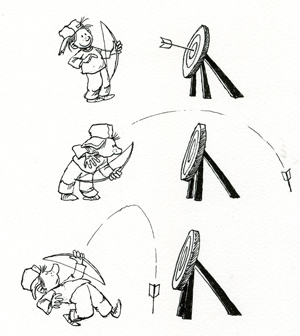 |
|
Bow and arrow |
| Try to convince nobody, that is something the other one has to do himself. But good bowman know it: if the bow is bent too loosely, the arrow does not hit the desired target. Is the bow bent too tightly, then the arrow will go past its target. Only if the bowman has feeling for the correct tension from his own experience and intuition the arrow can hit the target. The bowman is the counsellor of the child. The tension is the circumstance inside and outside the counsellor and the children. The arrow is the meeting, the interaction. The aim is ‘being hit’, getting involved and your wellbeing. |
| |
| |
| Not or, but and |
| Where does the counsellor stop and where does the child begin? An ecological approach is situated in the tension of the two forces. It is not either offer-oriented or demand-oriented. It is demand-oriented within the right offer. It is not process-oriented or product-oriented; it is maximum attention for the process in order to get the product as eminent as possible. It is not with attention for wellbeing or involvement; it is with (alternating) attention for both. I endorse the revolution of the renewal of education, the turning, all processes that lead to the emancipation of the child. But not by becoming technical or dogmatic; not without losing the nuance of the tension that is necessary to stimulate development in a pleasant way. ‘’Not or, but and’ means that you will have to link. ‘Or’ is delinking. ‘And’ is linking. Getting a joint perspective in view is the constructive challenge. |
| |
| |















